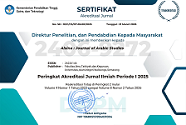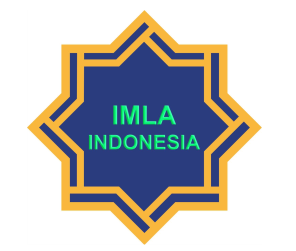Al-Aṣwāt wa Dalālātuhā ‘inda Ibn Taimiyyah
Abstract
Phonetic problems in Arabic are classic problems studied since the age of Al-Khalil bin Ahmed Al-Farahidi (d. 170 AH). This science is still being studied and developed to this day and has even become something that cannot be separated from linguistics. Ibn Taymiyah was an expert in religious knowledge who paid great attention to sound and its meaning. On this basis, through the use of semantic descriptive analysis, this research seeks to collect opinions regarding the meaning of sounds and at the same time compare them with what ancient and contemporary phonetic scholars have put forward regarding this issue. Among the results obtained from this research is the correspondence between the sounds in Arabic and the meaning. The strength of the sound indicates the strength of the meaning it contains, and vice versa. This study is really needed by Arabic language students, because some of them have difficulty memorizing Arabic vocabulary which is so large and cannot be distinguished from one another except by just one letter or just one vowel. Not only that, it is hoped that this research can contribute to knowledge on the topic of discussing semantics and phonetics.
Downloads
References
Ibn al-Athir, D. (1399). An-Nihayah fi Gharib al-Hadith wa al-Athar. Maktabah Ilmiah.
Al-Bukhari, M. (1414). Shahih al-Bukhari. (5th ed). Dar Ibn Katsir.
Bisyr, K. (2000). Ilm al-Ashwat. Dar Gharib.
Ibn Taimiyyah, A. (1397). Syarh Hadith an-Nuzul. (5th ed). Maktab Islami.
Ibn Taimiyyah, A. (1404). Al-Istiqamah. (1st ed). Al-Imam Muhammad ibn Su’ud al-Islamiyyah University.
Ibn Taimiyyah, A. (1406). Minhaj as-Sunnah an-Nabawiyyah fi Naqdh Kalam asy-Syi’ah al-Qadariyyah. (1st ed). Al-Imam Muhammad ibn Su’ud al-Islamiyyah University.
Ibn Taimiyyah, A. (1416). Majmu’ al-Fatawa. (1st ed). Majma’ al-Malik Fahd.
Ibn Taimiyyah, A. (1420). At-Tis’iniyyah. (1st ed). Maktabah al-Ma’arif.
Ibn Taimiyyah, A. (1420). An-Nubuwwat. (1st ed). Adhwa as-Salaf.
Ibn Taimiyyah, A. (1422). Jami’ al-Masail. (1st ed). Dar ‘Alam al-Fawaid.
Ibn Taimiyyah, A. (1426). Bayan Talbis al-Jahmiyyah fi Ta’sis Bida’ihim al-Kalamiyyah. (1st ed). Majma’ al-Malik Fahd.
Ibn Taimiyyah, A. (1431). Ar-Radd ’ala al-Manthiqiyyin. Dar al-Ma’rifah.
Ibn Taimiyyah, A. (1440). Ar-Radd ’ala as-Subki fi Mas’alah Ta’liq ath-Thalaq. (3rd ed). Dar Ibn Hazm.
Ibn Taimiyyah, A. (1440). Syarh ’Umdah al-Fiqh. (3rd ed). Dar ’Atha’at al-’Ilm.
Ibn Taimiyyah, A. (1999). Al-Jawab ash-Shahih li Man Baddala Din al-Masih. (2nd ed). Dar al-’Ashimah.
Ibn al-Jazari, S. (1405). At-Tamhid fi ’Ilm at-Tajwid. (1st ed). Maktabah al-Ma’arif.
Al-Jundi, A. (1984). ‘Alamat al-I’rab Baina an-Nadzhar wa at-Tathbiq. Majallah Ma’had al-Lughah al-‘Arabiyyah – Umm al-Qura University, ed: 2, pg: 275-322.
Ibn Jinni, A. (2000). Sirru Shina’at al-I’rab. (1st ed). Dar al-Kutub al-‘Ilmiyyah.
Ibn al-Hajjaj, M. (1334). Shahih Muslim. Dar ath-Thiba’ah al-‘Amirah.
Hasan, N. (2018). ‘Ilm al-Ashwat al-‘Arabiyyah – Tathawwaratuha wa Nadzariyyatuha wa al-Istifadah minha li Ta’lim al-Lughah al-‘Arabiyyah. Majallah at-Ta’rib, Vol. 6, Ed. 2, pg: 143-156.
Husnain, S. (n.d.). ad-Dalalah wa an-Nahw. (1st ed). Maktabah al-Adab.
Al-Hamd, G. (1325). Al-Madkhal ila ’Ilm al-Ashwat al-‘Arabiyyah. (1st ed). Dar ‘Imad.
Al-Khuli, M. (2001). ‘Ilm ad-Dalalah (‘Ilm al-Ma’na). Dar al-Falah.
Ad-Dani, A. (1407). At-Tahdid fi al-Itqan wa at-Tajwid. (1st ed). Maktabah Dar al-Anbar.
Az-Zamakhsyari, M. (1993). Al-Mufashshal fi Shun’ah al-I’rab. (1st ed). Maktabah al-Hilal.
Ibn as-Sarraj, M. (n.d.). al-Ushul fi an-Nahw. Muassasah ar-Risalah.
Sibawaih, A. (1408). Al-Kitab. (3rd ed). Maktabah al-Khanji.
As-Sirafi, I. (2008). Syarh Kitab Sibawaih. (1st ed). Dar al-Kutub al-Ilmiyyah.
Ibn Abi Thalib, M. (1401). Al-Kasyfu ‘an Wujuh al-Qira’at as-Sab’I wa ‘Ilaluha wa Hujajuha. (2nd ed). Muassasah ar-Risalah.
Al-‘Ubaidi, I. (2002). Mabahith fi ‘Ilm al-Lughah wa al-Lisaniyyat. Maktabah Bustan al-Ma’rifah.
Al-’Azzami, M. (1435). Manhaj Ibn Taimiyyah fi al-Qira’at wa Atharuha fi Istidlalatiha. Al-Jami’ah al-Islamiyyah Gaza.
Al-Farahidi, I. (1431). Al-’Ain. Dar wa Maktabah al-Hilal.
Al-Qali, A. (1419). Al-Maqshur wa al-Mamdud. (1st ed). Maktabah al-Khanji.
Al-Mubarrid, M. (n.d.). al-Muqtadhab. ‘Alam al-Kutub.
Musa’idiyyah, L. (2016). Baina ad-Dalalah wa al-Ma’na. Afaq li al-‘Ulum, Vol. 1, ed. 2, pg: 97-110.
Mergani, I. (1430). Al-Ashwat wa Atharuha fi Taghyiy Binyah al-Kalimah al-‘Arabiyyah – Dirasah washfiyyah Lughawiyyah fi Majma’ al-Amthal li al-Maidani. Jami’ah Umm Durman al-Islamiyyah.
Published
How to Cite
Issue
Section
License

This work is licensed under a Creative Commons Attribution-NonCommercial-ShareAlike 4.0 International License.
Copyright
The copyright of the received article shall be assigned to the publisher of the journal. The intended copyright includes the right to publish the article in various forms (including reprints). The journal maintains the publishing rights to published articles. Authors are allowed to use their articles for any legal purposes deemed necessary without written permission from the journal, but with an acknowledgment to this journal of initial publication.
Licensing
In order for Alsina: Journal of Arabic Studies to publish and distribute research articles, the editors need publishing rights (transferred from author to publisher). This agreement relates to the transfer/publishing copyright license to Alsina: Journal of Arabic Studies but the authors still have significant rights to use and share their published articles.
Alsina: Journal of Arabic Studies supports the need for writers to share, disseminate and maximize the impact of their research and their rights on any database. As a journal article writer, you have the right to various uses of your articles, including that by the institution or company where you work. Copyright can be used without the need for special permission. Authors who publish articles in the Alsina: Journal of Arabic Studies have broad rights to use their work for teaching and scientific purposes without requesting permission, including:
- Use by the author for lectures, presentations, or conferences, with distribution of copies to participants;
- Distribution to colleagues for research use;
- Use in compilations of the author's subsequent work;
- inclusion in a thesis or dissertation;
- Reuse of sections or excerpts from articles in other works (with full acknowledgment of the final article);
- Preparation of derivative works (other than commercial purposes) (with full acknowledgment of the final article);
- Voluntary posting on open websites operated by authors’ or writers' agencies for scientific purposes
When submitting a manuscript, authors do so on the understanding that if accepted for publication, the copyright for publishing (publishing right) of the article shall be assigned/transferred to Alsina: Journal of Arabic Studies.
Authors whose articles are accepted for publication will receive confirmation via email and sent a Copyright Transfer Agreement.

 Accreditation
Accreditation 
 In Collaboration with
In Collaboration with 

 Visitors
Visitors  Article Template
Article Template





